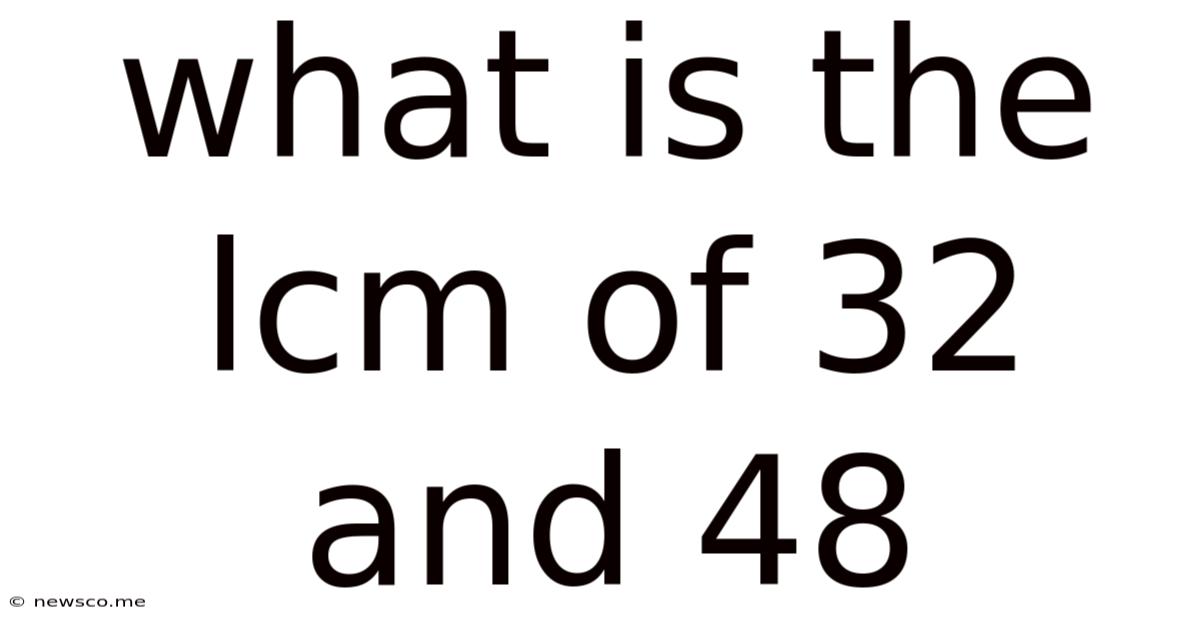What Is The Lcm Of 32 And 48
News Co
Apr 19, 2025 · 5 min read

Table of Contents
What is the LCM of 32 and 48? A Deep Dive into Least Common Multiples
Finding the least common multiple (LCM) of two numbers might seem like a simple mathematical task, but understanding the underlying concepts and different methods for calculating it can be incredibly valuable, especially when tackling more complex problems in algebra, number theory, and even programming. This article will explore what the LCM of 32 and 48 is, explain multiple ways to calculate it, and delve into the practical applications of LCMs.
Understanding Least Common Multiples (LCM)
Before we dive into the specifics of finding the LCM of 32 and 48, let's solidify our understanding of what an LCM actually is. The least common multiple of two or more integers is the smallest positive integer that is divisible by all the integers without leaving a remainder. Think of it as the smallest number that contains all the numbers as factors.
For instance, if we consider the numbers 2 and 3, their multiples are:
- Multiples of 2: 2, 4, 6, 8, 10, 12, 14, 16...
- Multiples of 3: 3, 6, 9, 12, 15, 18...
The common multiples are 6, 12, 18, and so on. The smallest of these common multiples is 6. Therefore, the LCM of 2 and 3 is 6.
Methods for Calculating LCM
There are several ways to determine the LCM of two (or more) numbers. We'll explore three common methods:
1. Listing Multiples
This is a straightforward method, particularly useful for smaller numbers. We list the multiples of each number until we find the smallest common multiple. While simple, it becomes less efficient with larger numbers.
Let's try this with 32 and 48:
- Multiples of 32: 32, 64, 96, 128, 160, 192, 224, 256...
- Multiples of 48: 48, 96, 144, 192, 240...
We can see that the smallest common multiple is 96. Therefore, the LCM(32, 48) = 96.
2. Prime Factorization Method
This method is more efficient, especially for larger numbers. It involves finding the prime factorization of each number and then constructing the LCM using the highest powers of each prime factor.
- Prime factorization of 32: 2 x 2 x 2 x 2 x 2 = 2<sup>5</sup>
- Prime factorization of 48: 2 x 2 x 2 x 2 x 3 = 2<sup>4</sup> x 3
To find the LCM, we take the highest power of each prime factor present in either factorization:
- Highest power of 2: 2<sup>5</sup> = 32
- Highest power of 3: 3<sup>1</sup> = 3
LCM(32, 48) = 2<sup>5</sup> x 3 = 32 x 3 = 96
3. Greatest Common Divisor (GCD) Method
This method utilizes the relationship between the LCM and the greatest common divisor (GCD) of two numbers. The formula is:
LCM(a, b) = (a x b) / GCD(a, b)
First, we need to find the GCD of 32 and 48. We can use the Euclidean algorithm for this:
- Divide the larger number (48) by the smaller number (32): 48 ÷ 32 = 1 with a remainder of 16.
- Replace the larger number with the smaller number (32) and the smaller number with the remainder (16): 32 ÷ 16 = 2 with a remainder of 0.
- The GCD is the last non-zero remainder, which is 16.
Now, we can use the formula:
LCM(32, 48) = (32 x 48) / 16 = 1536 / 16 = 96
Why is understanding LCM important?
The concept of LCM extends far beyond simple mathematical exercises. It has numerous practical applications in various fields:
1. Scheduling and Timing
Imagine you have two machines that complete a cycle every 32 and 48 seconds, respectively. To find out when they'll both be at the starting point of their cycles simultaneously, you need to find the LCM. The LCM (96 seconds) represents the time it takes for both machines to complete a full cycle simultaneously. This is crucial in manufacturing, transportation, and other time-sensitive processes.
2. Fraction Operations
Finding a common denominator when adding or subtracting fractions requires finding the LCM of the denominators. For example, adding 1/32 and 1/48 requires finding the LCM of 32 and 48, which is 96. This allows for easy addition: (3/96) + (2/96) = 5/96.
3. Music Theory
In music theory, the LCM is used to determine the least common period of two or more musical rhythms. This helps musicians understand rhythmic relationships and harmonies.
4. Computer Science and Programming
LCM calculations are used in various algorithms, particularly in areas like scheduling tasks, managing resources, and optimizing code.
5. Real-World Applications
The concept extends to various real-world scenarios like organizing events, coordinating schedules, and even solving problems related to tiling or pattern repetition.
Conclusion: The LCM of 32 and 48 is 96
Through various methods – listing multiples, prime factorization, and using the GCD – we've definitively established that the least common multiple of 32 and 48 is 96. Understanding how to calculate LCMs and their underlying principles is a fundamental skill with wide-ranging applications across multiple disciplines. This knowledge is not just limited to academic pursuits; it plays a crucial role in solving practical problems and improving efficiency in various real-world scenarios. Mastering this concept will significantly enhance your problem-solving abilities and provide a solid foundation for more advanced mathematical concepts. Remember to choose the method that best suits the numbers you are working with; for larger numbers, the prime factorization or GCD method will prove significantly more efficient.
Latest Posts
Related Post
Thank you for visiting our website which covers about What Is The Lcm Of 32 And 48 . We hope the information provided has been useful to you. Feel free to contact us if you have any questions or need further assistance. See you next time and don't miss to bookmark.